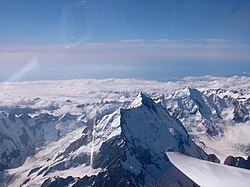Orogeny


Orogeny is the process of mountain-building. It takes place when two tectonic plates come together. Orogens develop while a continental plate is crumpled and thickened to form mountain ranges, and involve a great range of geological processes collectively called orogenesis.[1][2]
A convergent boundary is a frequent cause:
- Where a continent rides over an oceanic plate (non-collisional):
- Where two continental plates converge (collide):
Another, less common cause is when a plate moves over a hot spot in the Earth's mantle. Examples:
- Hawaiian chain of islands
- Yellowstone National Park
There is a third process, called delamination. Here an unstable portion of cold root of the lithosphere drips down into the mantle, decreasing the density of the lithosphere and causing buoyant uplift. Example:
- The Sierra Nevada in California.
Areas that are rifting apart, such as mid-ocean ridges and the East African Rift have mountains due to thermal buoyancy caused by the hot mantle underneath them, which pushes them up. This thermal buoyancy is known as dynamic topography. Examples:
- Variscan orogeny: older mountain belts caused by the formation of Pangaea.
References
[change | change source]- ↑ Tony Waltham (2009). Foundations of engineering geology (3rd ed.). Taylor & Francis. p. 20. ISBN 978-0415469593.
- ↑ Philip Kearey, Keith A. Klepeis, Frederick J. Vine (2009). "Chapter 10: Orogenic belts". Global tectonics (3rd ed.). Wiley-Blackwell. p. 287. ISBN 978-1405107778.
{{cite book}}: CS1 maint: multiple names: authors list (link)
